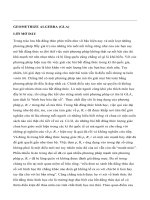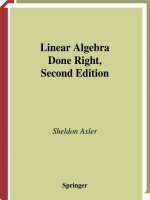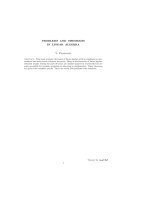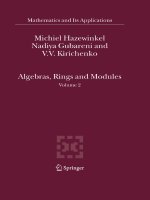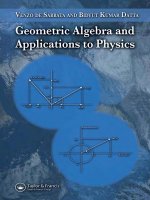67 Elementary Algebra
Bạn đang xem bản rút gọn của tài liệu. Xem và tải ngay bản đầy đủ của tài liệu tại đây (236.31 KB, 119 trang )
Elementary Algebra
Exam 1 Material
Familiar Sets of Numbers
•
Natural numbers
– Numbers used in counting:
1, 2, 3, … (Does not include zero)
•
Whole numbers
– Includes zero and all natural numbers:
0, 1, 2, 3, … (Does not include negative numbers)
•
Fractions
– Ratios of whole numbers where bottom number can
not be zero:
2 1 7
, , , etc
3 5 4
Top number is called " numerator"
Bottom number is called " denominator"
Prime Numbers
•
Natural Numbers, not including 1, whose only factors are themselves and 1
2, 3, 5, 7, 11, 13, 17, 19, 23, etc.
•
What is the next biggest prime number?
29
Composite Numbers
•
Natural Numbers, bigger than 1, that are not prime
4, 6, 8, 9, 10, 12, 14, 15, 16, etc.
•
Composite numbers can always be “factored” as a product (multiplication) of
prime numbers
Factoring Numbers
•
To factor a number is to write it as a product of two or more other numbers,
each of which is called a factor
12 = (3)(4)
3 & 4 are factors
12 = (6)(2)
6 & 2 are factors
12 = (12)(1)
12 and 1 are factors
12 = (2)(2)(3)
2, 2, and 3 are factors
In the last case we say the 12 is “completely factored” because all the factors
are prime numbers
Hints for Factoring Numbers
•
•
•
•
To factor a number we can get two factors by writing any multiplication problem that comes
to mind that is equal to the given number
Any factor that is not prime can then be written as a product of two other factors
This process continues until all factors are prime
Completely factor 28
28 = (4)(7)
28 = (2)(2)(7)
4 & 7 are factors, but 4 is not prime
4 is written as (2)(2), both prime
In the last case we say the 28 is “completely factored” because all the factors are prime
numbers
Other Hints for Factoring
•
•
•
•
Some people prefer to begin factoring by thinking of the smallest prime number that evenly divides the
given number
If the second factor is not prime, they again think of the smallest prime number that evenly divides it
This process continues until all factors are prime
Completely factor 120
120 = (2)(60)
60 is not prime, and is divisible by 2
120 = (2)(2)(30)
30 is not prime, and is divisible by 2
120 = (2)(2)(2)(15) 30 is not prime, and is divisible by 3
120 = (2)(2)(2)(3)(5) all factors are prime
In the last case we say the 120 is “completely factored” because all the factors are prime numbers
Fundamental Principle of
Fractions
•
If the numerator and denominator of a fraction contain a common factor, that
factor may be divided out to reduce the fraction to lowest terms:
•
Reduce to lowest terms by factoring:
12
18
1
1
12 2 ⋅ 2 ⋅ 3 2
=
=
18 21 ⋅ 3 ⋅ 31 3
When common factors are divided out, "1" is left in each place.
Summarizing the Process of
Reducing Fractions
•
•
Completely factor both numerator and denominator
Apply the fundamental principle of fractions: divide out common factors that
are found in both the numerator and the denominator
When to Reduce Fractions to
Lowest Terms
•
Unless there is a specific reason not to reduce, fractions should always be
reduced to lowest terms
•
A little later we will see that, when adding or subtracting fractions, it may be
more important to have fractions with a common denominator than to have
fractions in lowest terms
Multiplying Fractions
•
•
•
•
Factor each numerator and denominator
Divide out common factors
Write answer
Example:
1 1
1
5
2 ⋅ 2 3⋅5
4 15
⋅
=
⋅ =
21
3⋅3 2 ⋅ 2 ⋅ 7
9 28
1 1 1
Dividing Fractions
•
Invert the divisor and change problem to multiplication
•
Example:
2 3
2 4
÷ =
⋅ =
3 4
3 3
8
9
Adding Fractions Having a
Common Denominator
•
Add the numerators and keep the common denominator
•
Example:
5
2 3
+ =
7
7 7
Adding Fractions Having a
Different Denominators
•
•
•
Write equivalent fractions having a “least common denominator”
Add the numerators and keep the common denominator
Reduce the answer to lowest terms
Finding the Least Common
Denominator, LCD, of Fractions
•
•
Completely factor each denominator
Construct the LCD by writing down each factor the maximum number of times
it is found in any denominator
Example of Finding the LCD
•
•
Given two denominators, find the LCD:
18
,
Factor each denominator:
24
18 = 2 ⋅ 3 ⋅ 3
2 ⋅ 2 ⋅each
3 factor the maximum number of times it’s found in any
24 =LCD 2by⋅writing
• Construct
denominator:
What is the maximum number of times 2 is a factor? 3
What is the maximum number of times 3 is a factor? 2
LCD =
2 ⋅ 2 ⋅ 2 ⋅ 3 ⋅ 3 = 72
Writing Equivalent Fractions
•
Given a fraction, an equivalent fraction is found by multiplying the numerator and
denominator by a common factor
•
Given the following fraction, write an equivalent fraction having a denominator of 72:
•
Multiply numerator and denominator by 4:
5
18
How many times does 18 go into 72? 4
5
5 4 20
= ⋅ =
18 18 4 72
Adding Fractions
•
•
•
•
Find a least common denominator, LCD, for the fractions
Write each fraction as an equivalent fraction having the LCD
Write the answer by adding numerators as indicated, and keeping the LCD
If possible, reduce the answer to lowest terms
Example
5 7
+
18 24
•
Find a least common denominator, LCD, for the rational expressions:
We have already found that the LCD is 72
•
•
•
Write each fraction as an equivalent fraction having the LCD:
5 7
5 4 7 3
20 21
+
= ⋅ + ⋅ =
+
=
Write the answer by adding
or
subtracting
numerators
as
indicated,
and
keeping
the
LCD:
18 24 18 4 24 3
72 72
If possible, reduce the answer to lowest terms
20 21
+
=
72 72
41
72
41
72
Won' t reduce because numerator and denominator have no common factor
Subtracting Fractions
•
•
•
•
Find a least common denominator, LCD, for the fractions
Write each fraction as an equivalent fraction having the LCD
Write the answer by subtracting numerators as indicated, and keeping the
LCD
If possible, reduce the answer to lowest terms
Example
7 5
−
10 12
•
•
•
•
Find a least common denominator, LCD, for the rational expressions:
10 = 2 ⋅ 5
12 = 2 ⋅ 2 ⋅ 3
LCD = 2 ⋅ 2 ⋅ 3 ⋅ 5 = 60
Write each fraction as an equivalent fraction having the LCD:
7 5
7 6 5 5
42 25
− = ⋅ − ⋅ =
−
=
Write the answer by adding10
or subtracting
numerators
as
indicated,
and
keeping
the
LCD:
12 10 6 12 5
60 60
If possible, reduce the answer to lowest terms
42 25
−
=
60 60
17
60
17
60
Won' t reduce because numerator and denominator have no common factor
Improper Fractions
& Mixed Numbers
•
A fraction is called “improper” if the numerator is bigger than the denominator
7
fraction as an answer, but they can be
• There is nothing wrong with leaving an improper
3
changed to mixed numbers by doing the indicated division to get a whole number plus a
fraction remainder
•
Likewise, mixed numbers can be changed to improper fractions by multiplying
denominator times whole number, plus the numerator, all over the denominator
7
1
= 2
3
3
3
4 =
5
5 ⋅ 4 + 3 23
=
5
5
Doing Math Involving Improper
Fractions & Mixed Numbers
•
Convert all numbers to improper fractions then proceed as previously
discussed
3 7
23 7
23 3 7 5
34
69 35
4 − =
− =
⋅ − ⋅ =
−
=
5 3
5 3
5 3 3 5
15
15 15
34
4
=2
15
15
Either answer is okay
Homework Problems
•
•
•
•
•
Section:
1.1
Page: 11
Problems: Odd: 7 – 29, 33 – 51, 55 – 69
MyMathLab Homework 1.1 for practice
MyMathLab Homework Quiz 1.1 is due for a grade on the date of our next
class meeting
Exponential Expressions
34
•
“3” is called the base
“4” is called the exponent
An exponent that is a natural number tells how many times to multiply the base by itself
4
Example: What is the value of 3 ?
(3)(3)(3)(3) = 81
5 = 5 ⋅ 5 ⋅ 5 = 125
3
•
An exponent applies only to the base (what it touches)
•
Meanings of exponents that are not natural numbers will be discussed later
3 ⋅ 2 = 3 ⋅ 2 ⋅ 2 ⋅ 2 ⋅ 2 = 48
4
